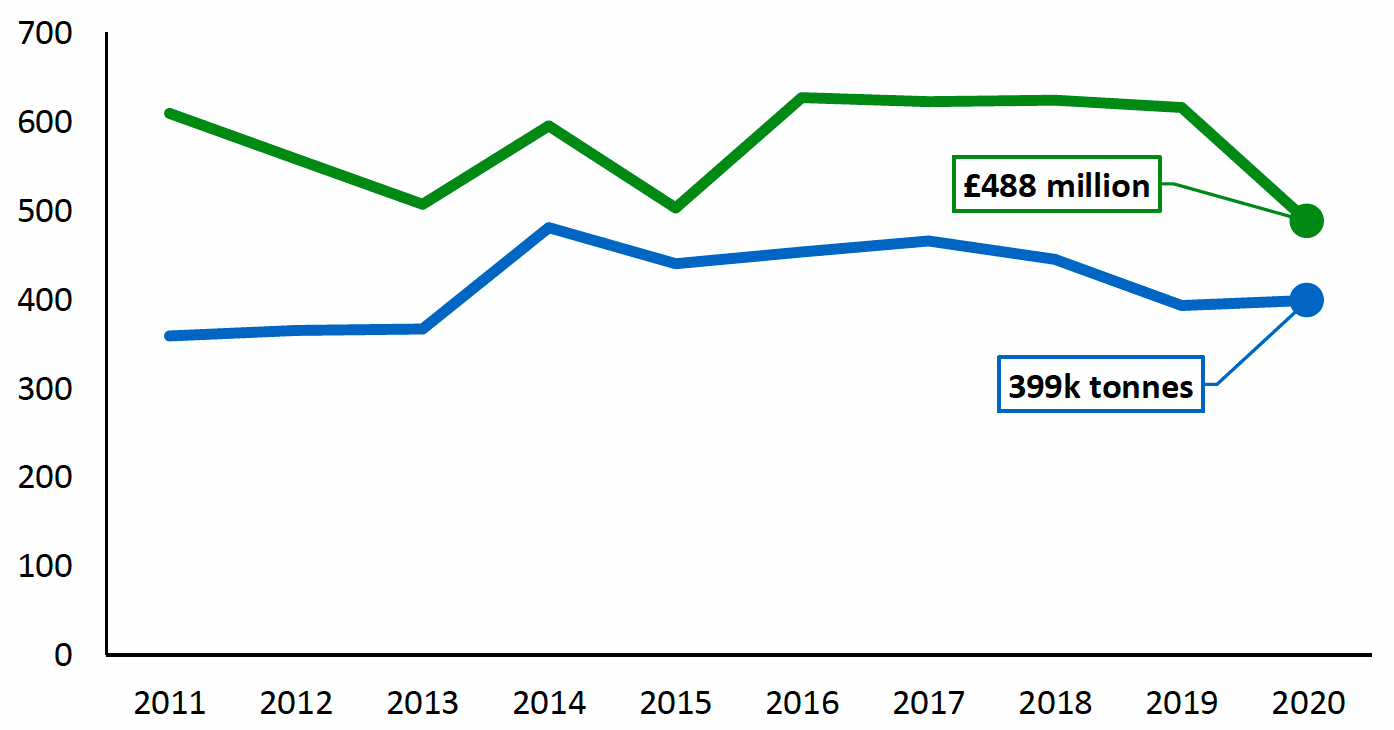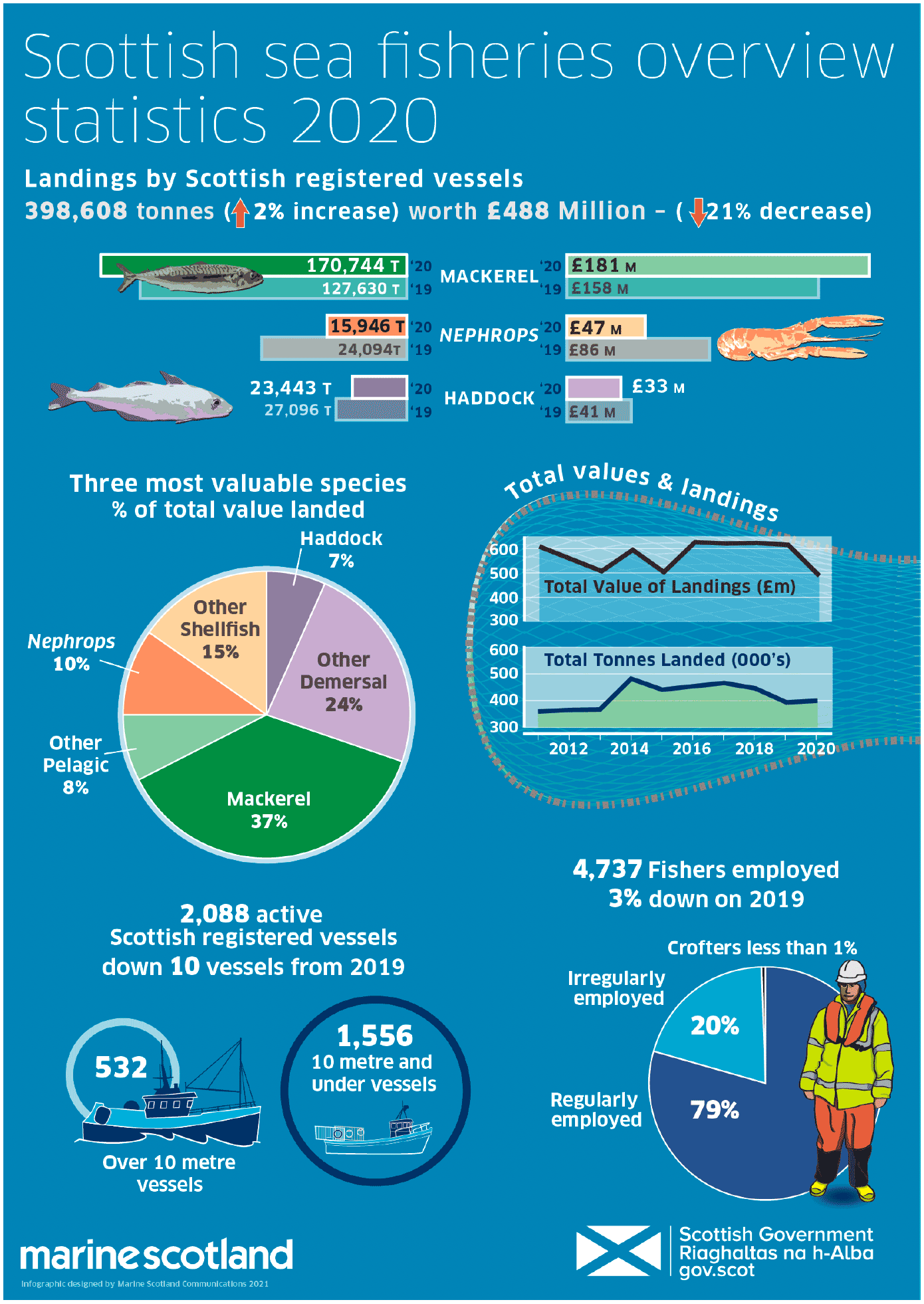Scottish Sea Fisheries Statistics 2020
National Statistics publication that provides data on the tonnage and value of all landings of sea fish and shellfish by Scottish vessels, all landings into Scotland, the rest of the UK and abroad, and the size and structure of the Scottish fishing fleet and employment on Scottish vessels.
2. Overview Statistics
2.1. Landings by Scottish vessels
In 2020, Scottish vessels landed 399 thousand tonnes of sea fish and shellfish with a gross value of £488 million. Compared to 2019 there was a decrease of 21 per cent in the real value of landings and a two per cent increase in the tonnage landed.
The decrease in real value was driven by shellfish and demersal species, as pelagic species increased in value. Shellfish species were worth £121 million, a fall of 42 per cent compared to 2019. Demersal species decreased 26 per cent in value to £149 million. Pelagic value increased six per cent to £218 million.
Landings by Scottish vessels accounted for 59 per cent of the value and 63 per cent of the tonnage of all landings by UK vessels in 2020 (Table 22a). Compared to 2019, the Scottish share of the total UK value has decreased by less than one percentage point and tonnage has increased by less than one percentage point.
Mackerel remained the most valuable species landed by the Scottish fleet, representing 37 per cent of the value of all Scottish vessels' landings. Nephrops is the second most valuable species, with 10 per cent of the total value. Haddock remained the most valuable demersal species with monkfish second and cod third. Together, haddock, monkfish and cod account for 18 per cent of the value of Scottish vessels' landings.
The tonnage of landings in 2020 was 40,000 tonnes (11 per cent) greater than in 2011. However, as shown in Chart 1, this was lower than the high seen in 2014. The general trend in real terms value of landings from 2016 to 2019 was fairly stable. However, due to the large decrease in the value of landings in 2020, the real terms value in 2020 decreased by £121 million (20 per cent) compared to 2011. This fall in 2020 was due to the impact of Covid-19 and this may not indicate a change in the long term trend.

2.2. The Scottish fishing fleet
There were 2,088 active Scottish fishing vessels in 2020, a decrease of 10 from 2019. In 2020, the number of over ten metre vessels was 532, down 7 vessels (one per cent) from 2019. There were 1,556 vessels in the ten metre and under fleet, a decrease of three vessels compared to 2019.
2.3. Employment
There were 4,737 fishers employed on Scottish registered vessels at the end of 2020. This figure is down three per cent (149 fishers) since 2019. Compared to 2019, there were 176 less regularly employed fishers (four per cent decrease), 50 more irregularly employed fishers (six per cent increase) and 23 less crofters.

Infographic Text below:
Scottish Sea Fisheries Overview Statistics 2020
Landings by Scottish registered vessels
398,608 tonnes (2% increase) worth £488 Million - (21% decrease)
Three most valuable species
% of total value landed
- Mackerel 37%
- Other Demersal 24%
- Other shellfish 15%
- Nephrops 10%
- Other Pelagic 8%
- Haddock 7%
2,088 active Scottish registered vessels down 10 vessels from 2019
- 532 vessels over 10 metres
- 1,556 vessels under 10 metres
4,737 Fishers employed 3% down 0n 2019
- Crofters less than 1%
- Irregulary employed 20%
- Regularly employed 79%
Contact
Email: fisheriesstatistics@gov.scot
There is a problem
Thanks for your feedback